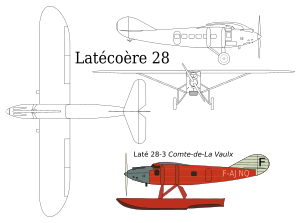Latécoère 28
| Latécoère 28 | |
|---|---|
 |
|
| Three view drawings of Latecoere 28 | |
| Role | Eight-passenger monoplane |
| Manufacturer | Forges et Ateliers de Construction Latécoère |
| First flight | 1927 |
| Primary user | Aéropostale |
| Developed from | Latécoère 26 |
The Latécoère 28 was a successful French long-haul mail plane and passenger airliner of the 1930s. It was the main-stay of Air France's predecessor, Aéropostale in its efforts to establish intercontinental air mail services and support French colonialism and French cultural influence between the wars.
Its pilots included famous poets and French men of letters such as Antoine de Saint Exupéry and Jean Mermoz as well as the usual veterans from World War I.
The Latécoère 28 was a development of the Latécoère 26. It was braced high-wing single-engined monoplane initially powered by Renault 12Jbr engine. The Latécoère 28 had a fixed tailwheel undercarriage and enclosed cockpit for two crew. The cabin was fitted for eight-passengers with access to a washroom.
A total of about fifty planes of several versions were built between 1927 and 1932. The seaplane version, the Latécoère 28-3, was the first to make a postal delivery crossing of the South Atlantic when Jean Mermoz flew from Dakar to Natal in 21 hours and a half aboard the Comte-de-La Vaulx (prototype n° 919) on 12 May 1930. [1] Unfortunately the plane was lost at sea during the return flight (with no loss of life, nor of mail).
This high-wing single engine plane was first built with Renault engines which were soon replaced by Hispano Suiza 12Lbr giving 500 hp (370 kW). The floatplane version had the Hispano Suiza 12Lbr giving 650 hp (480 kW).
The first aircraft were used by Aéropostale on the African mail routes connecting Casablanca and Dakar. The aircraft also inaugurated a Paris-Madrid service. It became famous in South America because of the regular mail service it ensured, from France to Argentina, and further on. With this plane it was possible to send a letter from Paris to Santiago de Chile in what seemed then like an astonishingly short four days. Previously, the mail steamships had taken weeks or months.
...
Wikipedia
